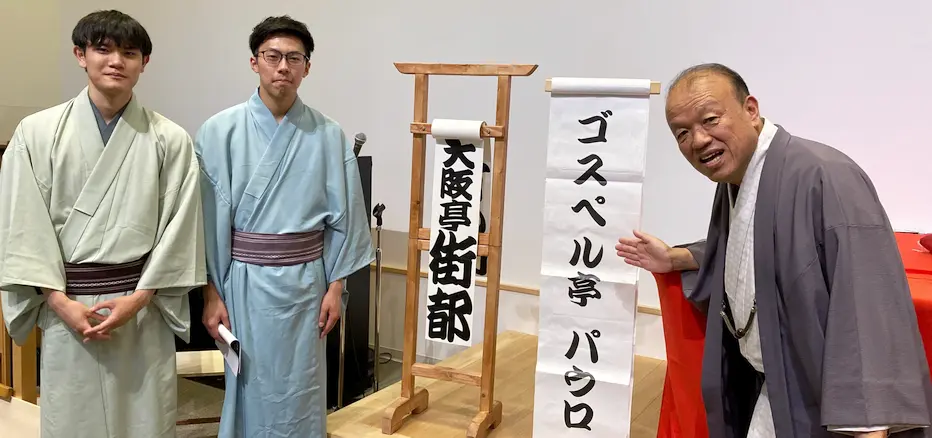Gospel Rakugo at church
With Gospel-tei Pauro and Handai Ochiken

On June 25th, a gospel rakugo event, Ishibashi Rakugo-kai, was held at the Mennonite Brethren Ishibashi Christ Church in Ikeda, Japan.
Before the coronavirus pandemic, the church had occasionally invited members of the local Rakugo Society of Osaka University (Handai Ochiken) to hold rakugo events in the church building. Amateur rakugo storyteller Gospel-tei Pauro and the Rakugo Society were invited to the church’s first post-pandemic rakugo event.
The opening act was Pauro’s lecture on rakugo for beginners, where he explained the roots and difference between kamigata and edo styles of rakugo. He also showed how one would typically use their sensu (Japanese fan) and tenugui (hand towel) as part of their storytelling. Once the audience had warmed up, Pauro, who also happens to be a disaster prevention trainer, went on to tell a story, asking, “What if an earthquake in the Nankai Trough were to hit now?” Through the eyes of the characters of the story, a clever boy and his not-so-bright mother, Pauro comically explains how one can prepare for such an event and how to act if an earthquake were to occur.
Osaka-tei Danbō, a sophomore student at Osaka University and a member of the Rakugo Society, told a classical rakugo story, “Tegami Muhitsu.” Osaka-tei Gaito, also a sophomore student, then told the story “Kasago.”
In closing, Pauro told a gospel rakugo story, “The lady that was forgiven her sins,” and the church hall filled with laughter. One person who attended said that the performances made them feel “warm and happy.”
On July 15th, Pauro performed at Wakayama Prefecture Worker Welfare Hall Plaza Hope for a peace-themed exhibition. His story was titled “My Name is Daigo Fukuryū Maru,” and it is based upon the true story of a fishing boat that was bombed by a thermonuclear weapon near Bikini Atoll in 1954.1 The story of the boat is well known, and a film has been made of it titled Lucky Dragon No.5. The title is a direct translation of Daigo Fukuryū Maru. Pauro performed the story with a desire to promote world peace.
From Christian Shimbun, July 9, 2023
Translated by Grace Koshino
1. “Daigo Fukuryū Maru,” Wikipedia, https://en.wikipedia.org/wiki/Daigo_Fukuryū_Maru (accessed October 24, 2023).
